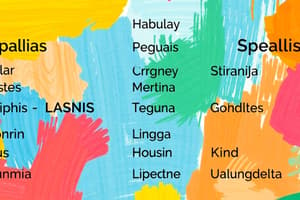Podcast
Questions and Answers
¿Qué significa 'hornear' en inglés?
¿Qué significa 'hornear' en inglés?
- To fry
- To burn
- To grill
- To bake (correct)
¿Cuál de las siguientes palabras (Which of the following words) se relaciona directamente con la acción de consumir (is directly related to the action of consuming) la comida?
¿Cuál de las siguientes palabras (Which of the following words) se relaciona directamente con la acción de consumir (is directly related to the action of consuming) la comida?
- Comer (correct)
- Quemar
- Freír
- Cocinar
¿Qué cubierto (utensil) en la cocina típicamente se usa para la acción de (is used in the action of) cortar ingredientes?
¿Qué cubierto (utensil) en la cocina típicamente se usa para la acción de (is used in the action of) cortar ingredientes?
- La cuchara
- El cuchillo (correct)
- El horno
- El vaso
¿Qué verbo significa 'to want' en español?
¿Qué verbo significa 'to want' en español?
¿Qué verbo significa 'to eat lunch' en español?
¿Qué verbo significa 'to eat lunch' en español?
¿Cuál de los siguientes verbos se usa para expresar 'to sleep' en español?
¿Cuál de los siguientes verbos se usa para expresar 'to sleep' en español?
¿Qué verbo se usa para expresar 'to recommend' en español?
¿Qué verbo se usa para expresar 'to recommend' en español?
Study Notes
Spanish 1: A Deep Dive into Vocabulary and Stem-Changing Verbs
Learning Spanish involves mastering a wide range of vocabulary and grammatical concepts. Two essential aspects of the language are stem-changing verbs, which alter their stem when conjugated, and specific vocabulary sets, including those related to the kitchen. This article will explore these topics in detail.
Vocabulary in the Kitchen
Knowing vocabulary is crucial for understanding a new language, especially in everyday situations. Learning cooking-related vocabulary is often helpful because it provides a practical application of newly acquired knowledge. Some common Spanish words related to the kitchen include:
almorzar: To have lunch.comenzar: To begin.continuar: To continue.cortar: To cut.cocinar: To cook.desayer: To serve (a meal).empanar: To stuff (food inside dough).equipar: To equip.hornear: To bake.licuar: To blend.pepinar: To seed (fruits or vegetables).preparar: To prepare.probar: To taste or try (food).sazonar: To season.zumbar: To make noise, as in stirring a pot.
Stem-Changing Verbs
Stem-changing verbs are those that undergo vowel changes when conjugated, creating a different stem for each pronoun. There are three types of stem-changing patterns in Spanish:
E to IE
| Querer – to want |
|---|
| yo |
| tú |
| él |
Similarly-conjugated verbs:
| advertir – to warn |
|---|
| ascender – to go up |
| atravesar – to cross |
| cerrar – to close |
| comenzar – to begin |
| descender – to go down |
| despertarse – to wake up |
| divertirse – to have fun |
| empezar – to begin |
| entender – to understand |
| mentir – to lie |
| pensar – to think |
| perder – to lose |
| preferir – to prefer |
| quebrar – to break |
| querer – to want |
| recomendar – to recommend |
| sentarse – to sit down |
| sentirse – to feel |
O to UE
| Poder – can, to be able to |
|---|
| yo |
| tú |
| él |
Similarly-conjugated verbs:
| acercarse – to approach |
|---|
| acostarse – to go to bed |
| almorzar – to eat lunch |
| contar – to count |
| costar – to cost |
| doler – to hurt |
| dormir – to sleep |
| encontrar – to find |
| jugar* – to play |
| mostrar – to show |
| oler** – to smell |
| probar – to try |
| recordar – to remember |
| soler – to be used to |
| volar – to fly |
| volver – to return |
In jugar, the U changes to UE (juego, juegas, etc.), and in oler, the O changes to HUE (huelo, hueles, etc.).
E to I
| Repetir – to repeat |
|---|
| yo |
| tú |
| él |
Similarly-conjugated verbs:
| despedirse – to say good-bye |
|---|
| gemir – to moan, groan |
| impedir – to prevent |
| medir – to measure |
| pedir – to ask for |
| reír – to laugh |
| seguir – to follow, continue |
| servir – to serve |
| sonreírse – to smile |
| vestirse – to dress |
Conclusion
Understanding stem-changing verbs and kitchen vocabulary is crucial for learning Spanish effectively. By practicing conjugation patterns and familiarizing yourself with commonly used words, you can enhance your comprehension and communication skills. Keep exploring these topics and verbs to further develop your understanding and proficiency in the language.
Studying That Suits You
Use AI to generate personalized quizzes and flashcards to suit your learning preferences.
Description
Explore a comprehensive guide to Spanish vocabulary in the kitchen and stem-changing verbs. Learn essential cooking-related words and understand the patterns of stem-changing verbs like E to IE, O to UE, and E to I. Enhance your Spanish language skills by mastering these crucial aspects.




